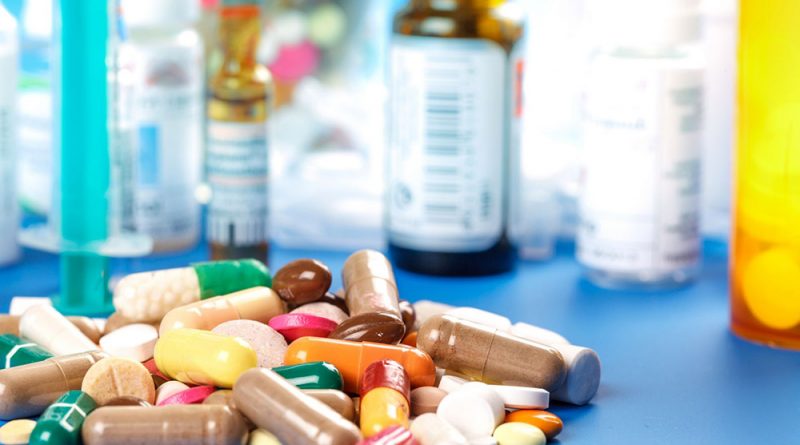Pharmaceutical industry in Iran
The pharmaceutical industry in Iran began in its modern form in 1920 when the Pasteur Institute of Iran was founded. Iran has a well-developed pharmaceutical production capability, however, the country still relies on imports for raw materials and many specialized drugs. The standards regarding pharmaceutical products are determined and modified by the Pharmacopeia Council. As of 2019, Iran says it produces 80-90% of the raw materials needed inside the country.[22] These include microplates, omeprazole, tamsulosin hydrochloride, naltrexone base, sitagliptin phosphate, and pioglitazone in various sizes.[23]
Iran’s Ministry of Health and Medical Education (MOHME) has a mission to provide access to sufficient quantities of safe, effective and high quality medicines that are affordable for the entire population. Since the 1979 revolution, Iran has adopted a full generic-based National Drug Policy (NDP), with local production of essential drugs and vaccines as one of the main goals.[24]
Although over 85 percent of the population use an insurance system to reimburse their drug expenses, the government heavily subsidizes pharmaceutical production/importation in order to increase affordability of medicines, which tends also to increase overconsumption, overprescription and misuse of drugs, much like the abuse of pharmaceutical opioids in Iran such as the heavily prescribed codeine for moderate to severe pain. The regulatory environment of the country is rather strict on the import of drugs and pharmaceuticals towards companies that intend to enter into the market for the first time. The Ministry of Health and Medical Education is the main stakeholder of pharmaceutical affairs in the country.
Market
See also: Iranian targeted subsidy plan
In 2006, 55 pharmaceutical companies in Iran produce more than 96 percent (quantitatively) of medicines on the market, worth $1.2 billion annually.[25] Iran’s pharmaceutical market is estimated to be worth $1.87 billion (2008), $2.31 billion (2009), $3.26 billion (2011), $3,57 billion (2013) and $3.65bn by 2013 (projected).[3][26][27][28]
The drug market in Iran is heavily in favour of generic medicines, which contributed US$1.23bn to the total in 2009, with patented drugs at US$817mn and OTC medicines at US$262mn.[27]
The market share of local production (value-wise) has declined from 85.2% to 63.4% over the past 8 (Iranian) years (2009). In this period the value of importation has jumped from 14.8% to 36.6%. The government imposes 90% tariff on the import of drugs. In 2009, 1.8 million units of pharmaceutical products worth $1.2 billion were imported into Iran.[29] As of 2015, Iran’s share of global biotechnology market is half a billion US dollar.[30]
Products
See also: Industry of Iran
Iran has produced a wide range of pharmaceuticals for the treatment of cancer, diabetes, infection and depression.[31]
Iran is the first country in the East Mediterranean region which has the technical and scientific capability to export vaccines to various world countries.[32] Iran will gain self-sufficiency in vaccine production by 2014.[33] As of 2019, Iran produced 8 out of the 18 main vaccines for the human body.[34]
The new drugs launched in Iran for the treatment of MS include an interferon beta-1b by CinnaGen.[35] Gamma Immunex (recombinant interferon beta 1), Pegaferon (recombinant pegylated interferon (PEG-IFN)) and regenerative human factor VIII are among other recombinant-based medication made in Iran.[36] A generic version of fingolimod by Novartis has been launched as well as a biosimilar version of EMD Serono′s Rebif.[37]
Iranian researchers have developed 41 types of anti-cancer medications, overcoming the need for importing pricey cancer drugs from abroad (2011).[38][39][40] There are also 24 additional biosimilar drugs which Iran plans to bring into production by end of 2012.[41] Iran plans to become self-sufficient in biotech medicines production within 4 years.[42]
According to the Food and Drug Administration in 2014, drugs for sexual enhancement, weight control, aesthetics, height enhancement, hair growth and body building are among the more prevalent fake drugs on the market. Trade in counterfeit commercial drugs, most of which come from Pakistan, has become more lucrative than dealing in illegal narcotics.[43]
Innovation
See also: Science and technology in Iran and Flora in Iran
In recent years several drugmakers are gradually developing the ability to innovate, away from generic drugs production itself.[27] Iran has around 8000 species of plant life and researches indicate that more than 2300 species have remedial characteristics or can be used as cosmetic products;[44] only 100-300 of which are being used in pharmaceutical industries at present.[45][46] Iran has 80 percent of the world medicinal herbs. Due to lack of required technology, they are exported raw and in limited quantities to foreign markets.[46]
Pharmaceutical companies
See also: List of Iranian companies and National Iranian Petrochemical Company
Inside Aryogen, production line for AryoSeven
Inside AryoGen company’s production line.
There are 92 companies in Iran that are active in the pharmaceutical industry.[29] The Social Security Investment Co. (SSIC), Iran’s largest holding company, which is affiliated to the Ministry of Welfare, presently owns and controls 22 pharmaceutical manufacturing companies and possesses a 40% share of total pharmaceutical production in Iran.[47]
The leading pharmaceuticals company is Darou Pakhsh, which is majority-owned by the Social Security Organization. The company manufactures, distributes, imports and exports finished products and pharmaceutical raw materials. Darou Pakhsh has an annual turnover of US$400m and claims to have the largest research and development operation of any Iranian drug firm. The company formed a plasmapheresis joint venture with a German medical firm, Biotest AG, in early 2004.[4] As of 2010, 50% of raw materials and chemicals used in the drug manufacturing sector are imported.[48] Iranian pharmaceutical manufacturers are also disadvantaged by the government′s poor intellectual property protection regime and lack of foreign direct investment.[3]


